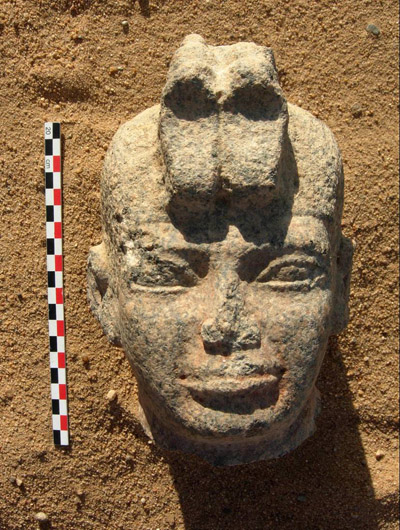

“Tantamani” took the throne after the death of King "Taharqa". He re-established the Upper Egyptian city of Thebes as a major religious center, restoring its many great temples and the power of the priests as an intellectual, spiritual and political force within Egypt ( ). He was the son of “Piankhi”, “Taharqa” was perhaps the greatest ruler of the 25th Dynasty and is certainly the best documented. Taharqa's reign can be dated from 690 BC to 664 BC. In Karnak he erected a pink granite statue of himself wearing the double crowns of Egypt ( ). It also saw an enormous amount of building work undertaken throughout Egypt, especially at the city of Thebes, which he made the capital of his Kingdom ( ). “Shabaka” succeeded his uncle “Shebitku” on the throne, Shabaka's reign is significant because he consolidated the Nubian Kingdom's control over all of Egypt from Nubia down to the Delta region. Among his most important monuments is his shrine in Karnak temple which was built near the sacred Lake.

He was a son of “Piankhi”, the founder of this dynasty ( ). “Shabatka” was the second King of the Twenty-fifth Dynasty of Egypt who ruled from 714 BC-705 BC, according to the most recent academic research. In spite of the great importance given in the sources to that King after the end of his reign, he is not considered as the real founder of the new dynasty, but the real founder of the twenty-fifth Dynasty in Egypt is King " Piankhi " ( ). The Kushite Dynasty which managed to invade Egypt and stabilize its control in the country started with King "Alra". The Twenty-Fifth Dynasty controlled Ancient Egypt from (744–656 BC). The Egyptian Sudanese relationship dates back to an early history as many of the monuments found in Egypt during the pre-dynastic age had contemporary counterparts in Sudan, even the civilization aspects in both countries were almost similar during the same period, the southern residents immigrated into Egypt since the earliest times but those immigrations remarkably increased during the time of the New Kingdom when Nubia has become an integral part of Egypt ( ). Thus, to achieve the aims of the study, it was followed the descriptive historical method of scientific research which deals with studying the subject, maKing comparisons, detecting similarities and differences, describing the pieces scientifically and studying the connections between them to find out the artistic bases of those influencesįoreign Influences Twenty Fifth Dynasty Kushite Period Kushite Kings Royal Statuary The aim of this study is to trace the difference between the Royal Egyptian art and the foreign, on the other hand, revealing the powers which affected the artistic changes that contributed in the progress of artistic works in that period, because the foreign influence during that period is one of the important aspects which largely affected the Egyptian civilization in general and the Egyptian arts in particular. Sherif Elsabban 1 Doaa Abd el-Motaal 1 Marwa El-Sayed Moustafa 2ġFaculty of Tourism and Hotels, Minia UniversityĢResearcher, Faculty of Tourism and Hotels, Minia University
Pharaoh taharqa statue pdf#
Minia Journal of Tourism and Hospitality Research MJTHRĪrticle 4, Volume 10, Issue 1, Summer and Autumn 2020, -104 PDF ( 1.6 MB)

This material may not be published, broadcast, rewritten or redistributed in whole or part without the express written permission of AncientPages.The Foreign Influences on Royal Statuary During the Kushite Period “25th Dynasty Written by - Ellen Lloyd – Ĭopyright © All rights reserved. These fascinating findings clearly show Egyptian and African traits and cultures fuse together. Pyramids are built, old traditions and gods are revived, and hieroglyphs and Egyptian iconography are appropriated by the new regime.Īfrican roots of the Nubians are apparent in connection with their funerary customs, as well as to how their culture remained strongly influenced by Egypt even after they retreated back to Nubia. The invading forces from the south appear almost more Egyptian than the Egyptians themselves. Two large stelae, for example, that were completely smashed during transit from Sudan some hundred years ago have now been put back together. Taharqa’s shrine with a ram at the entrance (Ashmolean Museum)Īrchaeologists and historians have been working hard to preserve the ancient Nubian legacy.


 0 kommentar(er)
0 kommentar(er)
